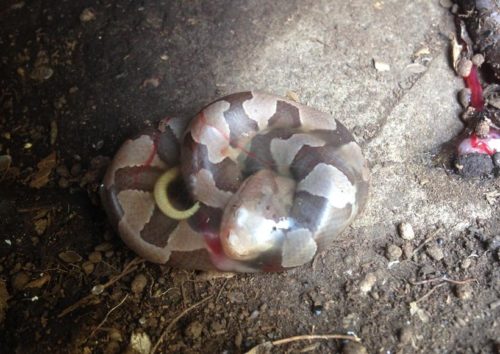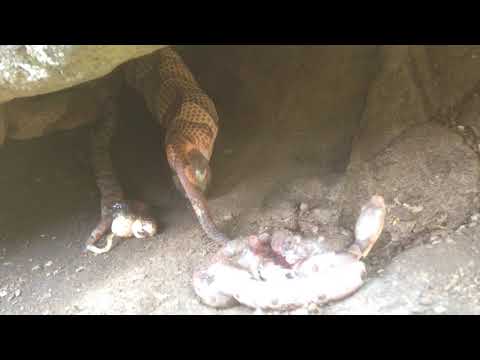MassWildlife’s Herpetologist captures the live birth of copperheads in the wild!
The copperhead, an endangered snake, is one of only two venomous snakes found in Massachusetts (the other is the endangered timber rattlesnake) where this video was taken. Both species give birth at the end of the summer. While people commonly misidentify milk snakes and northern water snakes as copperheads, actual copperhead sightings are very rare. Even more rare is the opportunity to see copperheads giving birth to their young! Luckily, MassWildlife Herpetologist Mike Jones was able to document a live birth.
Copperheads typically breed in the spring (although fall mating can also occur) and they usually give birth to 3–10 young in August or September. Jones admits he was lucky to capture the footage, “Females gather under rocks, in crevices, or other areas that are hard to access so observing the birth of a copperhead is something very few people have the opportunity to see.” Females giving birth tend to gather together in areas called birthing rookeries, which may be at their winter dens or sometimes up to a mile away. By giving birth at or near the winter den, it minimizes the distance newborns will have to travel from their birth site to where they will soon den for the winter.
Copperheads are ovoviviparous, which means they give birth to their young encased in an amniotic sac, rather than laying eggs like many other snakes. After giving birth, a copperhead mother does not care for her young. Each of the young is equipped with venom, fangs, and a supply of egg yolk for nourishment in their abdominal cavities.

Newborn copperheads measure about 7–9 inches long at birth and have a unique yellow tail tip which fades as it gets older. One hypothesis is that the juvenile snake uses its tail as a lure to capture prey. When the animal gets close enough, the copperhead can strike and acquire its meal.
As the young copperheads grow, they will face many threats. Destruction of rocky, wooded habitat and summer feeding grounds, excessive removal by collectors, and mortality at the hands of snake hunters and the general public continue to imperil the endangered copperhead.
Learn more at Mass.gov/supportNHESP.

